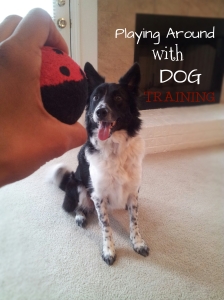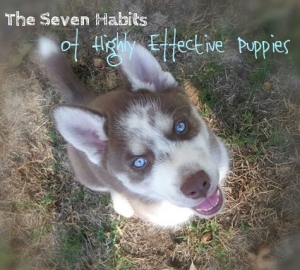“Once you have had a wonderful dog, a life without one, is a life diminished.”
—Dean Koontz (author, Whispers)
pet blog
Playing Around with Dog Training
My hand lifts up slowly and Storm’s eyes follow it, full of anticipation and razor sharp focus. He is seated and his head is slightly low, in classic Border Collie focus fashion. The ball in my grip is his only concern at this point, and he is poised to go as soon as I launch it down the hallway behind him. Except for one thing. I have now told him to “wait!” As I let go of the ball, it flies, fast and furious, towards the end of the hall. Storm is still planted in the same spot, looking at me and waiting, waiting, waiting for…”bring it!” Upon release of the magic words, he turns on a dime and goes after the ball as if his life depended on the retrieve. He quickly catches up to it, scoops it up with his mouth, and returns it to me for another throw.
This type of scenario happens often at our house. I am a big time multi-tasker, so anytime I can shove two tasks together in one frame of time, I do it! Hence, it is wonderful for me to be able to combine ever-important training with play when it comes to my dogs. This was especially true when I was considering competitive obedience for my dog Storm. I trained and/or reinforced the wait, send away, sit, down, stay, and drop on command…all through a retrieve! Not only did it make for more efficient training, it was fun!
Here’s how you can explore this type of training with your dog (or other pet). First of all, find out what types of play your dog really enjoys. Retrieving is a wonderful tool, and even if your dog is not a natural retriever, you can teach it! Click here for a great article by the ASPCA on how to do that. Tug can also be used, or perhaps you have a dog that likes to catch things (although similar, this can be different from the retrieve…I have cared for dogs who aren’t so excited about retrieving but think catching objects in their mouths is pure awesomeness). Touches or “tags” could also work! For instance, ask your dog to sit, and then offer a quick touch/tickle wherever your dog likes one after releasing him. Perhaps then puppy gets to chase you for a moment. Be open to thinking outside of the box!
Once you’ve found something motivating, us it as a reward for the behaviors you are trying to teach! You can show your dog how to do behaviors as you play with him. Targeting is great here, because you can teach your dog to target your finger and then use it to direct the dog quickly and then reinforce the behavior with play. In other instances, you can reinforce a behavior you have taught your dog via other methods by rewarding the behavior with play after you’ve requested it.
I always say, training should be fun, and there is not better fun than training a dog while playing with him. I hope you find some great ways to play around with your dog’s training!
No Stimulus Goes Unconditioned: Thinking out of the NILIF box
Following is a link to an excellent blog post about pairing classical and operant conditioning in dog training (might as well use all the tools in the toolbox, right?). It speaks to me particularly because I strongly believe in resolving behavioral problems, not simply putting a bandage over them. Check it out here: No Stimulus Goes Unconditioned: Thinking out of the NILIF box. Here’s a sneak peak to get you started:
When I first read Kathy Sdao’s book, Plenty in Life is Free, I cried. I cried because her words made sense. I cried because she described the incredible impact, negative and positive, we can have on our dogs’ lives through what we choose to reinforce, and through the contingencies we place on those reinforcers. It’s a daunting responsibility, but one that is so rewarding if done correctly.
As you can probably guess by now, I do not recommend Nothing in Life is Free (NILIF) protocols for my training clients. Sdao explains the pitfalls of NILIF much more eloquently than I ever could, so I will refer you to her book for those details. At times, depending on the severity and urgency of a behavioral problem, I will “close the economy,” meaning I ask owners to feed their dogs a certain portion of their food via training, either via classical or operant conditioning. But this is different from NILIF, and this difference is critical when working with fear-based behaviors.
The Seven Habits of Highly Effective Puppies
I have often been called upon to help owners address their dog’s behavioral problems. Pulling on leash, jumping up on the company and mouthiness have commonly topped the doggie list of fun stuff to do, much to the chagrin of pet parents. What owners often don’t realize is that many of the behaviors that are considered problematic are rooted in things the dog learned (or did not learn) as a puppy. I know, look at that face, right? Who is going to tell that cute little fluffball not to playfully nip or to jump up for attention when it’s so darn adorable. Well, puppy owners ask yourselves, will that be adorable when you add 20, 40 or even 100 pounds to the dog? Will that enthusiasm still be endearing when it pushes your out of the way or knocks you over? Unless you are a glutton for punishment, I am thinking we vote no on that one!
In an effort to get things started on the right foot, I have come up with a list of The Seven Habits of Highly Effective Puppies. Now don’t be deterred, ye owners of older dogs. Although the puppy stage may be long gone for your dog, you can still work to get your dog on track and moving forward, so read on and have some fun!
Habit #1: Knows how to use its mouth properly. A highly effective puppy should be taught early on that mouthing, particularly on human flesh, is not good. Instead of allowing it, give the puppy alternatives of things to chew on, such a Kong toys, Nylabones, and even some chewable toys. Just make sure the puppy remains supervised so that chewing doesn’t result in such destruction that the puppy can be harmed. You can also discourage mouthing by quietly putting the puppy up for a short time out if mouthing persists after a gentle “no.”
Habit #2: Jumps for joy, not for attention. Train a puppy to sit for petting as early as it can grasp the concept of sitting down. If it jumps, don’t reward it with attention and turn away (if it helps, think “oh my, how rude!” to add extra flair and fun to the turn). If puppy’s paws all land on the floor and, bonus points, it sits, give it lots of praise for a job well done!
Habit #3: Knows the leash and how to use it. Get your puppy used to a collar and leash early on. Even before you decide to embark on walks, you can place a leash on your pup and let him drag it around for a bit (under supervision please). You can also hold it for little walks around the house, if puppy will tolerate it, but don’t force compliance. At this stage, keep it fun and reward tolerance with lots of treats, petting and/or praise!
Habit #4: Understands the fundamentals of the training game. The “training game,” in this instance, refers to the fact that the puppy understands that what he does can generate rewards…especially if you ask for it. Work on short sessions of basic training with your pup on such things as sit, down, come, stay and heel. Help your puppy by asking for a behavior, showing him what to do, and then praising him/rewarding him for a correct response. Soon it’s possible he’ll be rehearsing for you to see what generates a treat.
Habit #5: Keeps and eye on its owner. Doggie attention on you is a great thing to reinforce as soon as the dog can focus on your for any length of time. When your puppy’s eyes are glued to you, make a fuss. Reward your dog. Share a hug with the canine. You can even throw a command on it (“watch me” is a favorite)! Attention is going to be a great resource when you start doing serious training with your dog, as it will help you override some distractions and allow you to help your dog get the message when you ask for something. Also, for some dogs that end up being reactive with other animals/people, you can use “watch me” to help doggie calm down a bit while he lays eyes on his favorite human. Of course, we are going to minimize all of the reactive business by instilling habit #6…
Habit #6: Loves being part of the community. Socialize, socialize, socialize. As soon as your vet says it’s safe to do so, take your pup out and about, and help him develop into a social butterfly! It’s imperative that interactions be kept as positive as possible, so a bit of planning may be needed to construct some puppy play dates, visit a local store on a not-so-busy afternoon, or go to the dog park when the crowd is manageable (and you feel comfortable with the play buddies present). Have various people give your dog treats, pet your dog, play with your dog and do other things that your pup just loves. Encourage polite interactions with other dogs and get excited about the fun. Also, as your puppy is out and about, have him encounter different surfaces and stimuli (mulch, gravel, sand, bicycles passing, lawnmowers in the distance, etc.). Pair treats with them to set up a positive association. It’s a fun world out there! Encourage him and reward bravery.
Habits #7: Marks its territory outside. This one really requires your help! Although there are some pups out there who will be quick studies when it comes to potty training, most dogs will require a good length of time and dedication to get this thing right. Make sure your puppy gets plenty of trips outside, particularly after mealtimes, after vigorous play, after long naps and before/after bedtime (as well as throughout the night as needed). Set up a potty spot where your pup will be encouraged to leave lots of presents. Call him Santa’s Little Helper, if that makes it more fun. Also, make sure your little dog is always supervised when inside, so that you can catch potential or occurring accidents and get your puppy outside, where he can do the right thing. Crate training is a great tool during this process, but never leave your dog crated for too long! If it’s practical, you can also tether your puppy to yourself to keep him close when you are occupied.
Having a puppy is a really exciting thing, and what’s even more exciting is knowing you can play a pivotal role in making your canine kid a well balanced, well adjusted adult dog! You just have to be habit forming!

